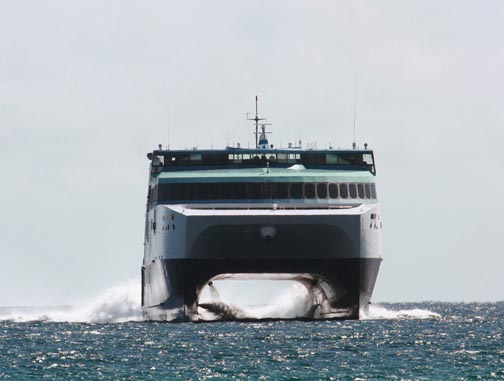-
|
-
-
-
- The Auditor State of Hawai‘i
-
- Report No. 08-11 December 2008
- Marion M. Higa Offi ce of the Auditor
- State Auditor 465 South King Street, Room 500
- State of Hawai‘i Honolulu, Hawai‘i 96813
- (808) 587-0800
- FAX (808) 587-0830
-
-
- OVERVIEW
- Performance Audit on the State Administration's Actions
- Exempting Certain Harbor Improvments to Facilitate
- Large Capacity Ferry Vessels from the Requirements of the
- Hawaiÿi Environmental Impact Statements Law: Phase II
- Report No. 08-11, December 2008
-
- Summary
-
- We conducted the second phase of this performance audit in response to Act 2,
- Second Special Session Laws of Hawaiÿi 2007. The audit examines the state
- administration’s actions against the requirements of the Hawaiÿi Environmental
- Impact Statements (EIS) law, Chapter 343, Hawaiÿi Revised Statutes. The audit
- reviewed the State’s actions in not considering potential secondary environmental
- impacts of the harbor improvements prior to granting the exemption from these
- requirements. The Phase I report, Report No. 08-09, was issued in April 2008.
- We found that with the impending arrival of Hawaiÿi Superferry, Inc., the Department
- of Transportation (DOT) in 2004 and 2005 reversed a long-standing policy of not
- providing additional pier-side equipment for harbor users. State officials ignored
- the recommendations of their technical staff, setting off a chain of events that
- culminated in the selection of inadequate harbor improvement systems. Moreover,
- the DOT’s passive approach to the issue of addressing secondary or cumulative
- effects was made possible by a combination of flawed or unclear EIS laws and rules.
- Saddled with a deadline imposed by Hawaiÿi Superferry and supported by
- administration officials, DOT technical staff implemented the only harbor
- improvement system that could meet their time horizon, a combination of barges
- and ramps, which was not their preferred choice. The state-funded $38.5 million
- harbor improvement system has proved to be problematic, best exemplified by
- Kahului Harbor’s barge, which is continually battered by high winds and waves.
- Not only have the barge and pier incurred more than $3 million in damages (the
- liability of which has yet to be determined), the barge also requires the services of
- a tug boat to secure it to the pier during ferry operations. Like the barge and pier
- damage, responsibility for this significant extra expense has yet to be determined.
- But the State has a larger and more expensive challenge over the horizon. Last
- summer, Hawaiÿi Superferry officials announced that they will be outfitting their
- second ship with an onboard ramp, a feature that eliminates the need for the $10
- million barge-and-ramp system at Kawaihae Harbor and the $2.5 million ramp at
- Näwiliwili Harbor, both built to accommodate Hawaiÿi Superferry and no other
- users. If company officials choose to retrofit their first ship, the Alakai, with
- a loading ramp, the State’s entire $38.5 million barge-and-ramp system would
- quickly become unnecessary. Because the barges were designed specifically for
- Hawaiÿi Superferry use, they cannot be repurposed in their present configuration
- by other harbor users. In addition, since they were built in China and are therefore
- prohibited from transporting cargo within U.S. waters, the barges may have little
-
- use for potential buyers. This situation would have been avoided if state officials
- had required Hawaiÿi Superferry to carry an onboard ramp in the first place.
- We also found that the legislation on behalf of Hawaiÿi Superferry compromised
- the State’s environmental laws and set a worrisome precedent for future
- government accommodation that puts the interests of a single business
- before the State’s environmental, fiduciary, and public safety responsibilities.
- Our recommendations are designed to address the flawed or unclear
- EIS law and rules. The Office of Environmental Quality Control in the
- Department of Health should establish guidelines, including a checklist
- for agencies to ensure that all of the steps required by the rules have been
- properly addressed and documented before according an exemption.
- The Environmental Council should establish a process to provide guidance to
- agencies in determining whether an action is projected to have a significant
- environmental impact which would make an exemption inapplicable;
- amend the EIS rules to ensure the OEQC provides training to state and
- county agencies; clarify the agency consultation process regarding proposed
- exempted actions; and establish clear definitions of cumulative and secondary
- impacts in regards to water carrier operations and the scope of their coverage.
- Finally, we recommend the DOT Harbors Division investigate options
- for a new barge mooring and fender system for the Kahului pier,
- determine responsibility for barge maintenance, and resolve financial
- liability issues over damage and unplanned expenses such as tug services.
- The DOT response sidesteps many of the issues and challenges some wording.
- But most of the language came from documents from the department.
- The department disagreed that on-board loading ramps would render the State’s
- $38.5 million barge-and-ramp system unnecessary. Yet, the ferries’ shipbuilder
- as well as ferry officials have declared that on-board ramps would avoid the use
- of the problematic barges.
-
- After a careful review and consideration of the department’s comments, we
- made minor changes and clarifications to our report, none of which affected our
- findings and conclusions.
-
- GO TO FULL REPORT
-
|
|
